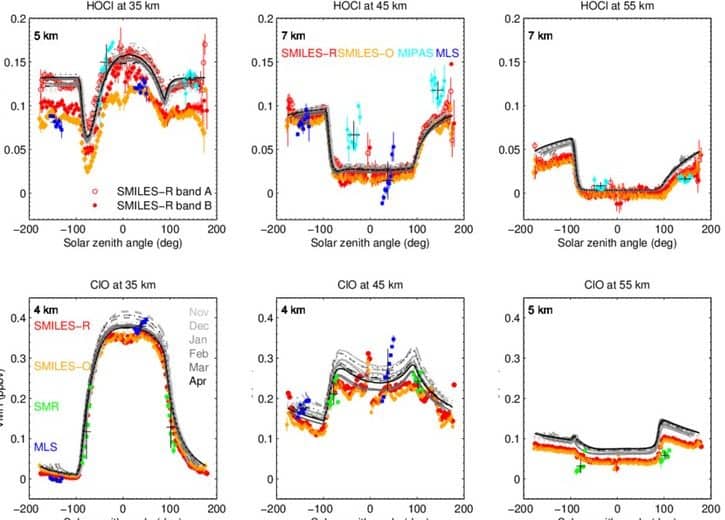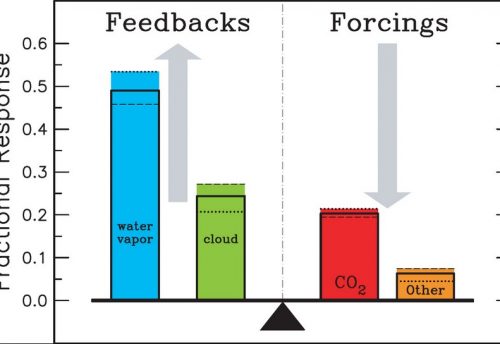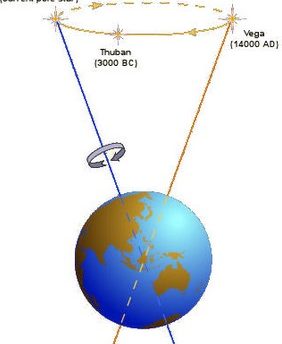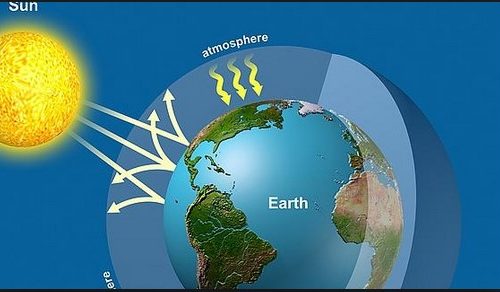
Although solar variability has been considered, a priori, to be another external forcing factor, it remains a controversial mechanism of climate change, across all time scales. Despite many attempts to show statistical associations between various solar periodicities and global climate cycles, no realistic causal mechanism has been proposed to link the two phenomena.
The best known solar cycle is the variation in the number of sunspots over an 11 year period. Sunspot cycles are thought to be related to solar magnetic variations, and a double magnetic cycle (approximately 22 years) can also be identified (Foukal, 1990; Gough, 1990; Weiss, 1990). What is of interest to a climatologist is whether the sunspot cycles are accompanied by variations in solar irradiance – the solar constant – which, potentially, could force climate changes. The solar constant (approximately 1368Wm-2) is a measure of the total solar energy flux integrated across all wavelengths of radiation. Two decades of satellite observations (e.g. Foukal, 1990) reveal that the solar constant varies over time scales of days to a decade, and there does appear to be a significant relationship with the sunspot number cycle. At times of high sunspot number, the value of the solar constant increases. Although sunspots are regions of cooler than average Sun surface temperature, their presence is accompanied by brighter (hotter) faculae which more than compensates for the increase in darker sunspot areas (Foukal, 1990; Kuhn et al., 1988). This relationship can be extended back over time using the long sunspot record. Solar irradiance changes thus calculated are reproduced in Figure 2.3.
The difficulty in attributing any observed climate change to these variations in solar irradiance is that the latter are small in magnitude – a change of much less than 1% over the course of the sunspot cycle. Wigley (1988) stressed that with such small variations in the solar constant, the global climatic response would be no more than a 0.03C temperature change. Nevertheless, many climatic records (e.g. indices of droughts, temperature and total atmospheric ozone) do appear, at least statistically, to display periodicity linked to one or both of the sunspot cycles (Mitchell et al., 1979; Newell et al., 1989). It should be clear, however, that a statistical association between solar variability and climate change does not prove cause and effect.
It is of course possible that the approximate 11-year cycle identified in many climate records is caused by some unknown internal oscillation and not by external solar forcing. It is conceivable that, simply by chance, the phase of the oscillation could coincide with the phase of the solar variability. More plausibly, an internal oscillation can become phase-locked to the solar cycles, thus augmenting the climatic response by a kind of feedback mechanism. For the time being, therefore, the link between the sunspot cycles and climate change must remain a speculative one.
However, there are other solar periodicities, with longer time scales that could be considered as climate forcing mechanisms. It has been suggested that the long-term variation in the amplitude of the sunspot cycles may have an influence on global climate (Eddy, 1982). Observations made with the naked eye reveal times when sunspot activity was very limited, including the Maunder Minimum (1654 to 1715) and the Spörer Minimum (1450 to 1534). These events occurred during the period known as the Little Ice Age (see section 5.3.2.4), and Eddy (1976, 1977) has hypothesised that the two may be causally linked. As with the sunspot cycles, however, the evidence is largely circumstantial. Other solar variations include cycles of sunspot cycle length (between about 9 and 13 years), changing solar diameter and the rate of change of solar diameter (Wigley & Kelly, 1990). Although some of these long-term variations may involve larger changes in solar output, this is again mere speculation.
Proxy records of solar irradiance changes are needed when even longer time scales are considered. A number of scientists (e.g. Hood & Jirikowic, 1990) have used records of 14C in tree rings to investigate the relationships between potential solar forcing mechanisms and climate change. Changes in the output of energetic particles from the Sun (the solar wind) are believed to modulate the production of 14C in the upper atmosphere. The magnetic properties of the solar wind change with the variation of sunspots, leading in turn to variations in the production of 14C (Stuiver et al., 1991). The effect of the solar wind is such that high 14C production is associated with periods of low sunspot number.
Relatively long and reliable 14C records are now available. Spectral analysis has revealed a number of solar periodicities including a 2,400 year cycle, a 200 year cycle, a 80 to 90 year cycle and the shorter 11 and 22 year cycles. The 14C records have also been correlated with a number a climate change indicators (Eddy, 1977), including glacial advance-retreat fluctuations and annual temperatures for England. Episodes of low 14C production are associated with high sunspot activity and warmer climates. It is certainly feasible that the climatic variations of the Holocene (last 10,000 years since the end of the last ice age), and the shorter fluctuations associated with the Little Ice Age have been forced by the interacting millennia and century scale cycles of solar activity. However, conclusive evidence of a mechanism linking cause and effect is again missing. In addition, numerical modelling of Wigley & Kelly (1990) seems to indicate that solar irradiance changes would not be substantial enough to bring about the observed climatic changes without invoking additional internal feedback mechanisms.




Leave a Reply